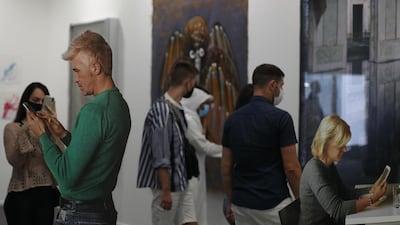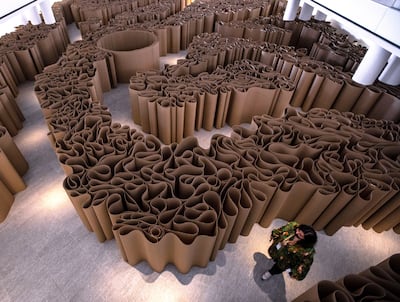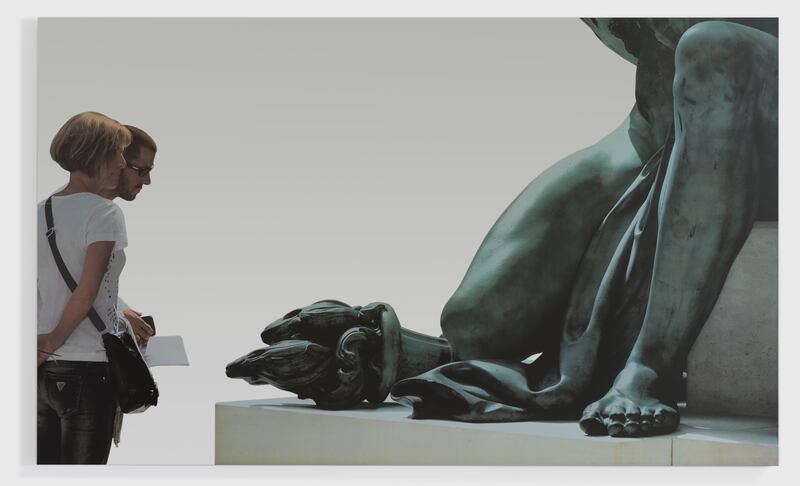Mirrors have long held our collective hopes and fears in their silver depths.
For the great Argentine writer Jorge Luis Borges, they were the madness of the infinite. In the Brothers Grimm fairy tale Snow White, the magic mirror was the voice of truth. In her lauded A Room of One’s Own, Virginia Woolf writes: “Whatever may be their use in civilised societies, mirrors are essential to all violent and heroic action.”
For Italian artist Michelangelo Pistoletto, mirrors are a fragile means to defy time and space. His mirror paintings at Louvre Abu Dhabi connect the museum, its artworks and visitors to its older Parisian sibling. Displayed across the permanent galleries of the museum, the mirror paintings can easily be missed at first glance. Depicting ancient sculptures and viewers admiring them, the work is camouflaged within the space, making it easy to mistake with the surrounding pieces.
The paintings, which come as part of Louvre Abu Dhabi’s fifth anniversary celebrations are on display until May 15. They continue from Year 1, Paradise on Earth, the 2013 work Pistoletto created for Musee du Louvre. For Louvre Abu Dhabi, the artist created 11 new mirror works depicting visitors and works from the collection of Musee du Louvre. The aim, Pistoletto says, was to create a dialogue from one Louvre to another.
“When I take a photograph of a sculpture, I can transport it to another place through my mirror paintings. That sculpture will then be connected to another place. You have in Abu Dhabi the works that are in Paris. Now, I would like to make a series in Paris featuring sculptures and viewers and the people of Abu Dhabi. I want to transport them to Paris,” Pistoletto tells The National.

Most of Pistoletto’s mirror paintings are composed around a series of oppositions: between people of the past and those of the present, between the nude and clothed body, and between a body of flesh and one of stone.
“The paintings are composed by a mirror surface and an image taken by photography. With technology, it was painted [or printed] on the mirror,” Pistoletto says. “It is reflecting the viewer, the space. It is of the realities existing through the mirror.”
Louvre + 1 Mirror Paintings, Pistoletto says, also covers the three aspects of time: past (photography), present (reflection in the mirror) and future (the photography becoming the memory of a moment that follows all succeeding moments).
“We have the dimension of time, the dimension of history,” he says. “When you put the work in a museum, you have a reflection of the history of the museum. We can see not only the history, but also the present and the viewer is included in the history and takes it into the future.
The temporary artworks also symbolise Louvre Abu Dhabi's roles as a mirror of humanity and a convergence point for ages and civilisations. Pistoletto is renowned for smashing his mirror paintings after his exhibitions conclude. He takes a sledgehammer to them, shattering their bottomless silver and suggestions of infinity. He did not specify whether he would do the same for the works at Louvre Abu Dhabi.

Louvre + 1 Mirror Paintings is not the first work Pistoletto has exhibited at Louvre Abu Dhabi. As part of the Stories of Paper exhibition, which took place in the summer of 2022, the artist presented his monumental Labirinto e Grande Pozzo installation, a snaking labyrinth of cardboard.
“The labyrinth was a way to make people enter the work physically,” he says. “The viewer is not just looking but is included in the work of art, moving inside of it.”
Louvre + 1 Mirror Paintings will be on display at Louvre Abu Dhabi until May 15







